Search
- Page Path
-
- HOME
- Search
- Original Article
- Neonatology (Perinatology)
- Comparison of minimally invasive surfactant therapy with intubation surfactant administration and extubation for treating preterm infants with respiratory distress syndrome: a randomized clinical trial
- Mohammad Kazem Sabzehei, Behnaz Basiri, Maryam Shokouhi, Sajad Ghahremani, Ali Moradi
- Clin Exp Pediatr. 2022;65(4):188-193. Published online July 28, 2021
-

Question: Are the short-term outcomes of minimally invasive surfactant therapy (MIST) relatively superior to those of INtubation, SURfactant administration, and Extubation (INSURE) in preterm infants with respiratory distress syndrome (RDS)?
Finding: MIST could be an appropriate substitution for INSURE in preterm infants with RDS since it reduced hospitalization time and number of side effects.
Meaning: MIST is recommended for surfactant administration for its proven advantages over the INSURE technique.
- Letter to the Editor
- Other
- Evaluation of simulation-based ultrasound course for pediatricians: a starting point for future training curriculum
- Chon In Kuok, Avis Siu Ha Leung, Jonan Chun Yin Lee, Winnie Kwai Yu Chan
- Clin Exp Pediatr. 2022;65(1):53-55. Published online July 28, 2021
-
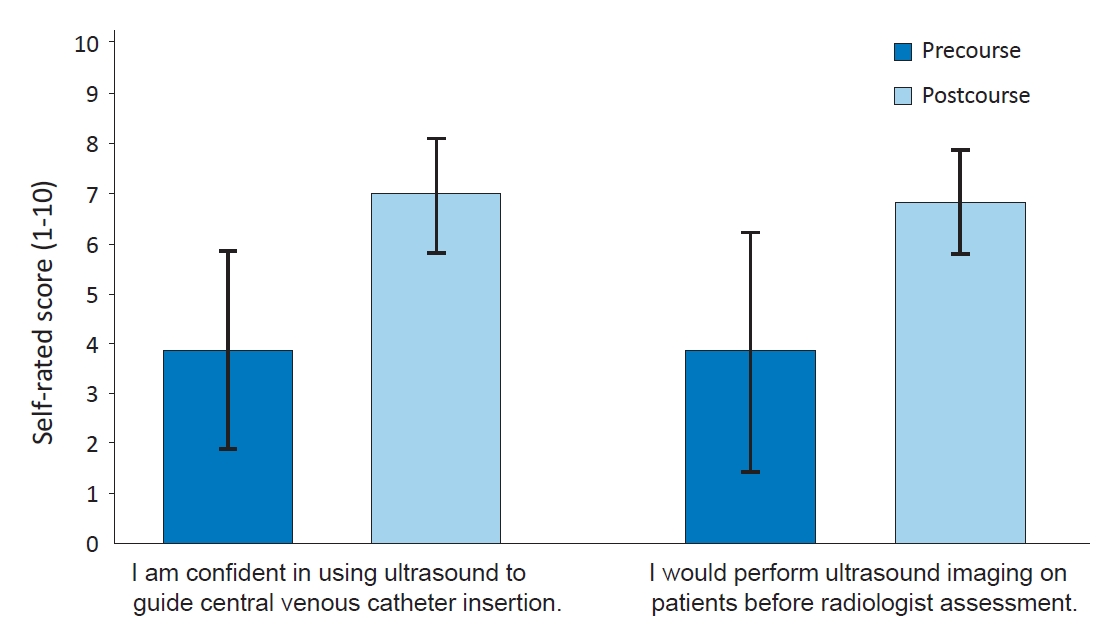
Question: Simulation-based ultrasound training is becoming more popular. Is there a role for pediatricians in such training programs?
Finding: Our program received promising feedback from its participants. Self-rated confidence in image interpretation and ultrasound-guided catheter insertion improved after the simulation. Participants reported a higher preference for performing ultrasound scans before radiologist assessment.
Meaning: Ultrasound training can be considered as part of the pediatric training curriculum in the future.
- Editorial
- Oncology
- Infantile hemangioma: timely diagnosis and treatment
- Meerim Park
- Clin Exp Pediatr. 2021;64(11):573-574. Published online July 22, 2021
-

While the majority of infantile hemangiomas (IHs) do not require therapy and regress spontaneously, about 10%–15% develop complications such as ulceration, obstruction, or disfigurement. Early intervention is recommended for infants with potentially problematic IHs. Oral propranolol 2–3 mg/kg/day is currently the treatment of choice.
- Review Article
- Neonatology (Perinatology)
- Growth patterns of preterm infants in Korea
- Joohee Lim, So Jin Yoon, Soon Min Lee
- Clin Exp Pediatr. 2022;65(1):1-9. Published online July 8, 2021
-
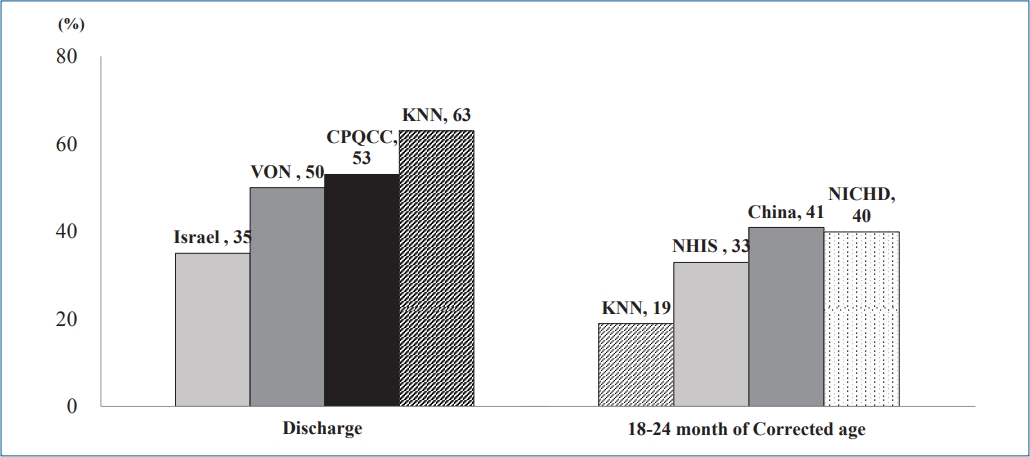
∙ The growth of preterm infants is a main focus of neonatology.
∙ Preterm infants in Korea, especially those with a very low birth weight, achieve retarded growth.
∙ Careful growth monitoring and early intervention will contribute to better development outcomes and quality of life for preterm infants and improve public health.
- Hematology
- Thrombosis and severe acute respiratory syndrome coronavirus 2 vaccines: vaccine-induced immune thrombotic thrombocytopenia
- Young Shil Park
- Clin Exp Pediatr. 2021;64(8):400-405. Published online June 30, 2021
-

· Thrombosis and thrombocytopenia occurring within 4–28 days after severe acute respiratory syndrome coronavirus 2 vaccination require attention.
· The terms vaccine-induced immune thrombotic thrombocytopenia (VITT) and thrombosis with thrombocytopenia syndrome (TTS) are used.
· VITT is pathogenetically similar to heparin-induced thrombocytopenia.
· VITT/TTS could be associated with the development of platelet-activating anti-platelet factor 4 antibodies.
· For suspected VITT/TTS, early treatment decisions (intravenous immunoglobulin, non-heparin anticoagulant, and avoidance of platelet transfusions) are important.
- Infection
- Updates on the coronavirus disease 2019 vaccine and consideration in children
- Hyun Mi Kang, Eun Hwa Choi, Yae-Jean Kim
- Clin Exp Pediatr. 2021;64(7):328-338. Published online June 21, 2021
-

· The number of coronavirus disease 2019 cases has exponentially increased worldwide, and children ≤19 years old account for 11.0% of all confirmed cases.
· mRNA vaccines, BNT162b2 and mRNA-1273, and adenoviral vector vaccines, AZD1222 and Ad26.COV2.S, authorized for emergency use in the Emergency Use Listing of the World Health Organization are reviewed.
· Clinical trials of these vaccines have shown that they are safe and serious adverse reactions are rarely observed.
- Original Article
- General Pediatrics
- Gross motor dysfunction and balance impairments in children and adolescents with Down syndrome: a systematic review
- Preyal D. Jain, Akshatha Nayak, Shreekanth D. Karnad, Kaiorisa N. Doctor
- Clin Exp Pediatr. 2022;65(3):142-149. Published online June 11, 2021
-
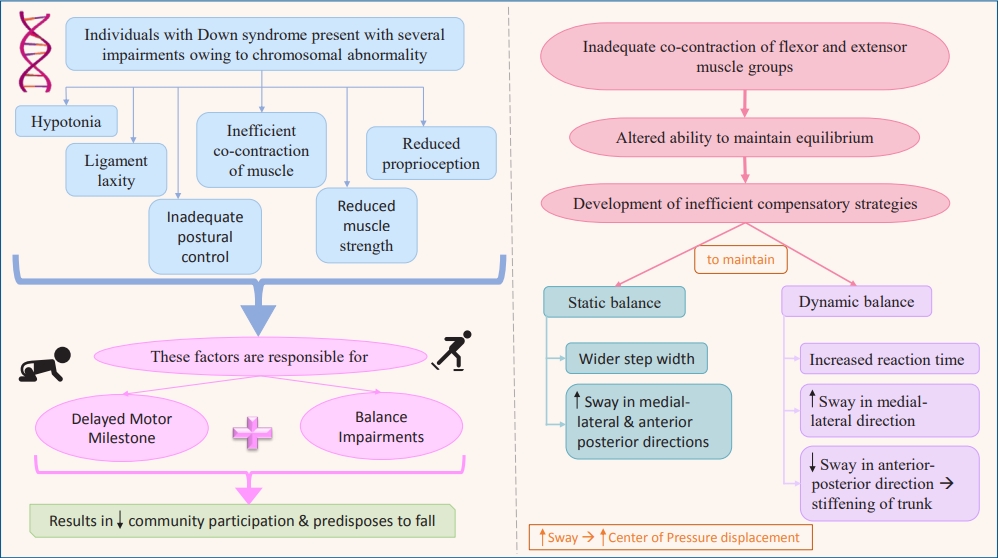
Question: What are the primary motor and balance dysfunctions in children with Down syndrome?
Finding: These individuals have gross delays, altered balance, and inefficient compensatory mechanisms.
Meaning: Neuromuscular and musculoskeletal impairments due to the chromosomal abnormality lead to developmental delay. These children also exhibit poor balance with greater instability and inefficient compensatory mechanisms including altered center of pressure displacement and trunk stiffening that predisposes them to falls.
- Editorial
- Other
- Global trend and disparity of acute lower respiratory infection as cause of mortality in children under 5 years of age
- Abdul Wahab
- Clin Exp Pediatr. 2021;64(12):630-631. Published online June 11, 2021
-
Acute lower respiratory infection (ALRI) is the leading cause of death among children under 5 years of age worldwide, especially in low- and middle-income countries. A spatial analysis explains the trends and severity based on the conditions of each country. Countries in Asia and Africa experience many cases of mortality caused by ALRI.
- Review Article
- Infection
- Recommendation for use of diphtheria and tetanus toxoids and acellular pertussis, inactivated poliovirus, Haemophilus influenzae type b conjugate, and hepatitis B vaccine in infants
- Hye-Kyung Cho, Su Eun Park, Yae-Jean Kim, Dae Sun Jo, Yun-Kyung Kim, Byung-Wook Eun, Taek-Jin Lee, Jina Lee, Hyunju Lee, Ki Hwan Kim, Eun Young Cho, Jong Gyun Ahn, Eun Hwa Choi; The Committee on Infectious Diseases of the Korean Pediatric Society
- Clin Exp Pediatr. 2021;64(12):602-607. Published online June 8, 2021
-
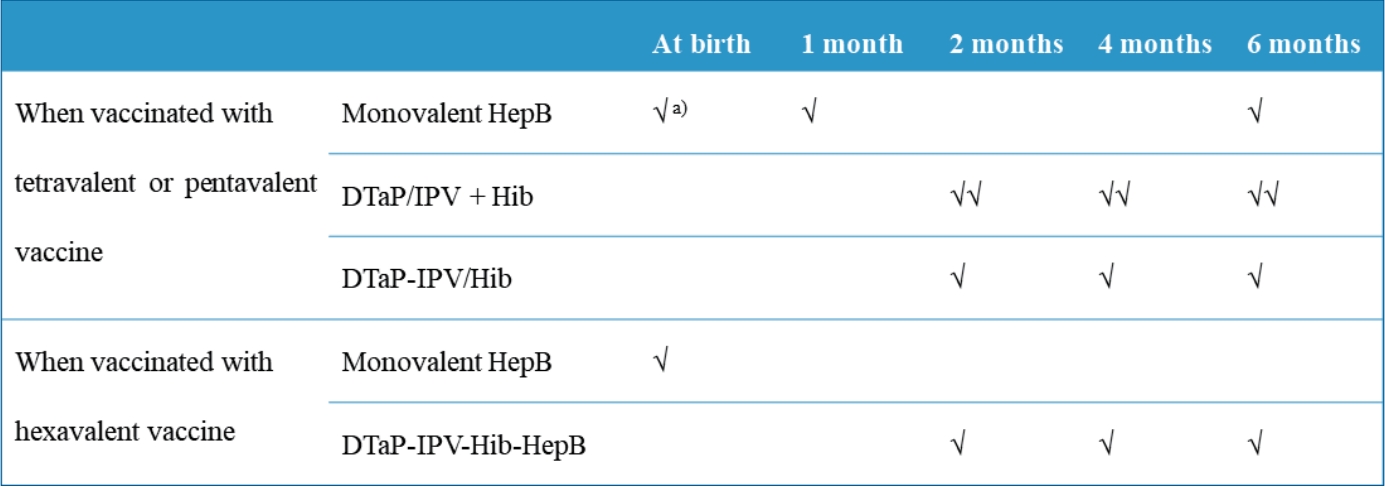
∙ Diphtheria and tetanus toxoids and acellular pertussis-inactivated poliovirus-Haemophilus influenzae type b-hepatitis B (DTaP-IPV-Hib-HepB) was licensed in Korea in April 2020.
∙ DTaP-IPV-Hib-HepB is indicated as a 3-dose primary series for infants aged 2, 4, and 6 months who received the standalone HepB vaccine at birth.
∙ Infants born to HepB surface antigen-positive mothers are currently recommended to be immunized with HepB immunoglobulin at birth and then monovalent HepB vaccine at 0, 1, and 6 months.
- Original Article
- Cardiology
- Vasovagal syncope with mild versus moderate autonomic dysfunction: a 13-year single-center experience
- Han Eoul Lee, Dong Won Lee
- Clin Exp Pediatr. 2022;65(1):47-52. Published online June 1, 2021
-
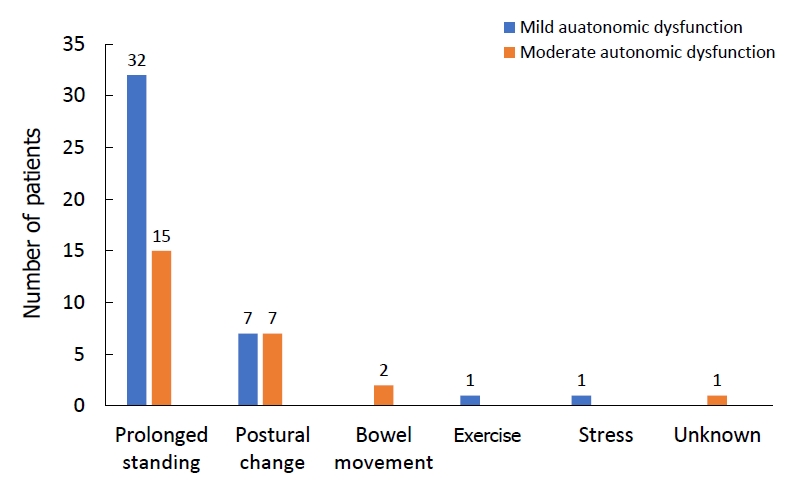
Question: It is well known that autonomic dysfunction contributes to vasovagal syncope (VVS). Does the degree of autonomic dysfunction contribute to clinical manifestations, diagnostic methods, treatment, and prognosis?
Finding: The clinical manifestations, diagnostic methods, treatment, and prognosis differ between patients with mild and moderate degrees of autonomic dysfunction.
Meaning: VVS is caused by autonomic dysfunction, but autonomic dysfunction severity need not be classified.
- Editorial
- Nephrology (Genitourinary)
- Obesity and chronic kidney disease: what should pediatric nephrologists know?
- Jung Won Lee
- Clin Exp Pediatr. 2021;64(10):521-522. Published online June 1, 2021
-
• Obesity is not only a comorbidity of hypertension, it may be a riskfactorfor chronickidneydisease.
• Renal impairment associated with obesity is believed to start early in childhood and continue into adulthood, implying a higher risk of adverse cardiovascular events.
• The identification of kidney injury, implementation of preventive strategies, and prompt treatment are essential to improving clinical outcomes in obese children with early kidney disease.
- Review Article
- Infection
- School closures during the coronavirus disease 2019 outbreak
- Eun Young Cho, Young June Choe
- Clin Exp Pediatr. 2021;64(7):322-327. Published online May 31, 2021
-
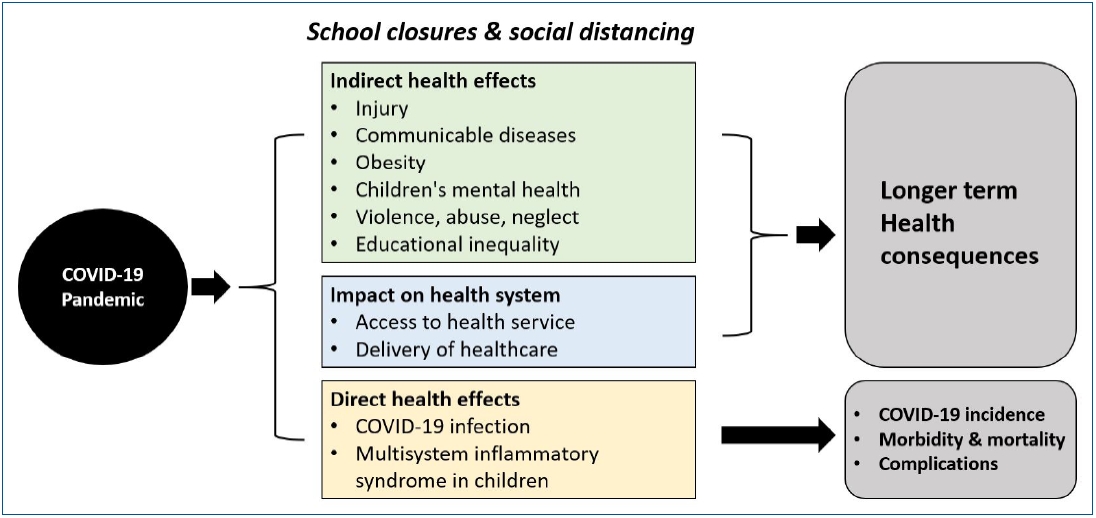
· Earlier modeling studies of the effects of school closures on severe acute respiratory syndrome coronavirus 2 were largely derived from the pandemic influenza model, resulting in conflicting implications.
· Observational findings suggest no clear effect of school closures on community transmission or overall mortality.
· School closures must be weighed against potential high social costs, which can also negatively affect children’s health.
- Oncology
- Update on infantile hemangioma
- Hye Lim Jung
- Clin Exp Pediatr. 2021;64(11):559-572. Published online May 26, 2021
-

· Infantile hemangiomas (IHs) are the most common benign vascular tumors, occurring in 5%–10% of infants.
· IHs are characteristically not present at birth but are usually diagnosed at 1–4 weeks of age, rapidly proliferate until 5 months of age, and then spontaneously involute.
· High-risk IHs (10%) require early treatment from 1 month of age.
· Oral propranolol, a nonselective beta-blocker, is the first-line treatment for IHs.
- Original Article
- Pulmonology
- Modified high-flow nasal cannula for children with respiratory distress
- Sarocha Itdhiamornkulchai, Aroonwan Preutthipan, Jarin Vaewpanich, Nattachai Anantasit
- Clin Exp Pediatr. 2022;65(3):136-141. Published online May 24, 2021
-
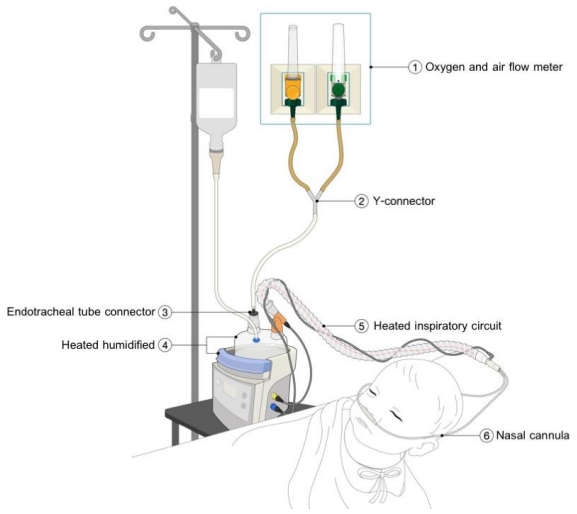
Question: Can the modified high-flow nasal cannula (HFNC) provide alternative respiratory support for children with acute respiratory distress?
Finding: A total of 74 patients were assigned to the modified or commercial HFNC groups. The intubation rate, length of hospital stay, and adverse events did not differ between the 2 groups.
Meaning: The modified HFNC can provide alternative respiratory support for pediatric respiratory distress.
- Review Article
- Neurology
- Cognitive outcomes in late childhood and adolescence of neonatal hypoxic-ischemic encephalopathy
- Bo Lyun Lee, Hannah C. Glass
- Clin Exp Pediatr. 2021;64(12):608-618. Published online May 24, 2021
-
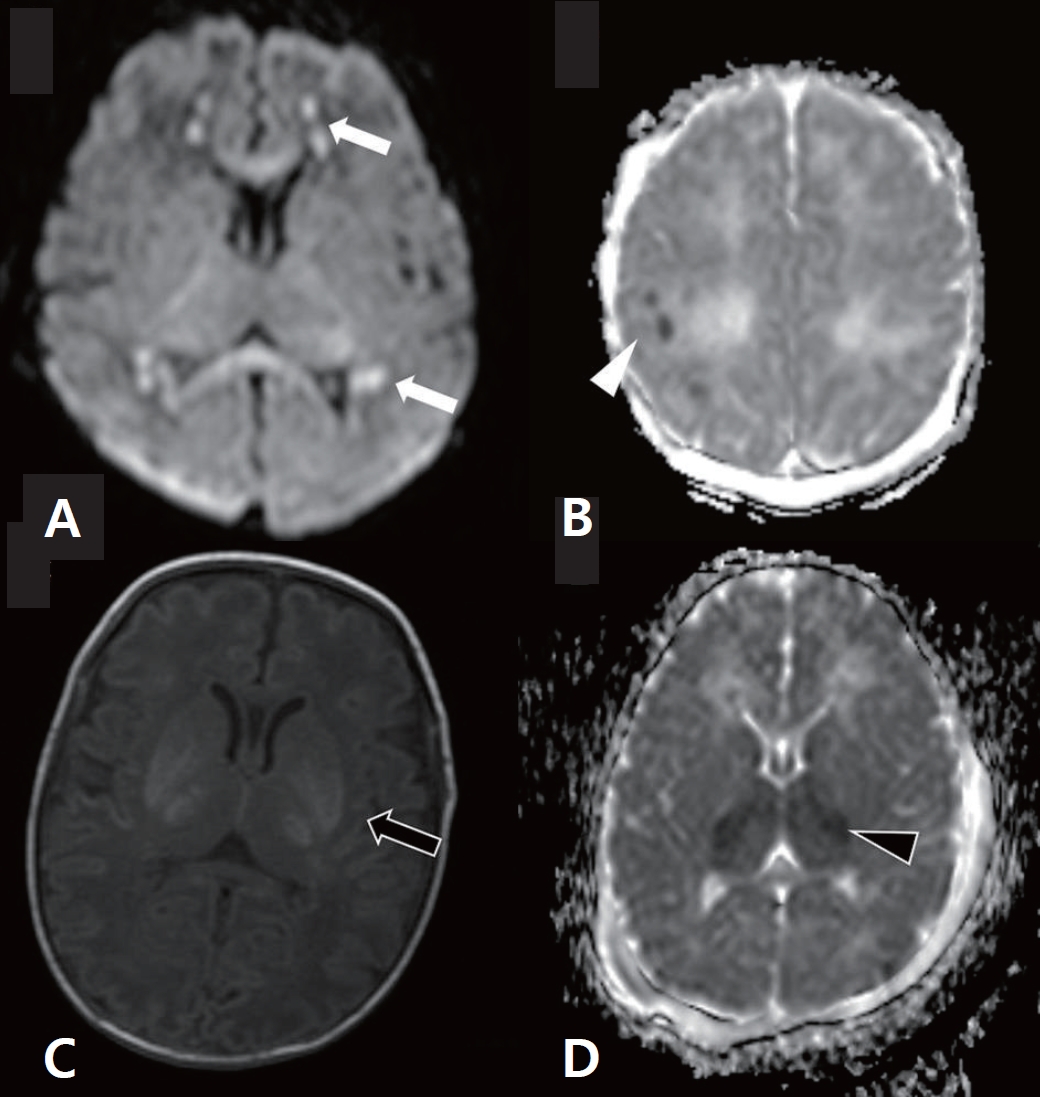
∙ Cognitive impairments occur in children with hypoxic-ischemic encephalopathy (HIE) even without neuromotor deficits.
∙ Therapeutic hypothermia has improved neurodevelopmental outcomes of children with HIE; however, 40% of children remain at risk of death/disability or cognitive impairments necessitating the development of adjunctive neuroprotective therapies.
∙ Long-term follow-up until adolescence is required to identify cognitive dysfunction.
∙ A pattern of watershed injury on brain imaging is associated with poor cognitive outcomes.
- Original Article
- Emergency Medicine
- Comparison of clinical features and laboratory findings of coronavirus disease 2019 and influenza A and B infections in children: a single-center study
- Meraj Siddiqui, Ayşe Gültekingil, Oğuz Bakırcı, Nihal Uslu, Esra Baskın
- Clin Exp Pediatr. 2021;64(7):364-369. Published online May 18, 2021
-
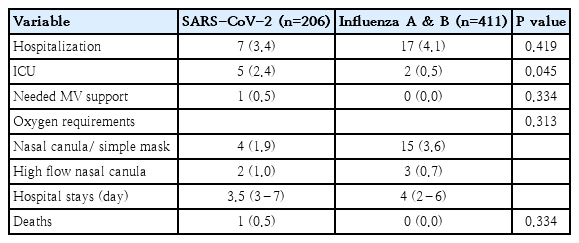
Question: What are the differences between coronavirus disease 2019 (COVID-19) and influenza infections in children?
Finding: Pediatric COVID-19 patients predominantly exhibited respiratory and/or gastrointestinal symptoms, neurological manifestations, olfactory/gustatory dysfunction, elevated monocytes, mildly elevated C-reactive protein, and unilateral or diffuse abnormalities on chest x-ray. Patients with underlying medical conditions had higher intensive care unit admission rates and should be followed closely.
Meaning: The clinical presentations of pediatric COVID-19 patients varied from asymptomatic/mild to severe.
- Review Article
- Nutrition
- Changes in health status of North Korean children and emerging health challenges of North Korean refugee children
- Seong-Woo Choi
- Clin Exp Pediatr. 2021;64(11):552-558. Published online May 17, 2021
-

· Among North Korean refugee (NKR) children under 5 years, 61% and 9.3% were underweight in 1998 and 2017, respectively.
· The immunization rate of NKR children exceeded 90% since 2006.
· For NKR children, protein-energy malnutrition was the #1 cause of death in 2009 versus #17 in 2019.
· In 2020, stunting affected 5.4% and 0.9% and obesity affected 10.7% and 2.7% of NKR versus South Korean children, respectively.
- Letter to the Editor
- General Pediatrics
- Hyperinflammatory syndrome in children during the coronavirus disease 2019 pandemic in sub-Himalayan region
- Seema Sharma, Shikha Verma, Isha Bhatia, Ravinder Singh, Mohit Bajaj, Milap Sharma
- Clin Exp Pediatr. 2021;64(7):370-372. Published online May 11, 2021
-
Question: Is there an increase in patients with hyperinflammatory syndrome during the coronavirus disease 2019 pandemic?
Finding: We found 10 patients with hyperinflammatory syndrome with poor outcome during a period of 2 months in a single tertiary care centre.
Meaning: Pediatricians who come across patients with muco cutaneous manifestations and multiorgan involvement should consider hyperinflammatory syndrome. Early recognition and prompt treatment of such patients may result in promising outcome.
- Original Article
- General Pediatrics
- Effect of maternal and child factors on stunting: partial least squares structural equation modeling
- Agus Santosa, Essa Novanda Arif, Dinal Abdul Ghoni
- Clin Exp Pediatr. 2022;65(2):90-97. Published online May 4, 2021
-

Question: What effects do maternal and child factors have on stunting? Are there significant indicators of stunting?
Finding: Child and maternal factors had 49.8% and 30.3% effects on stunting, respectively. The primary child factor was infant formula dose, while the primary maternal factor was nutritional status.
Meaning: More attention to nutritional status during pregnancy and ensuring the appropriate dose of infant formula at ages 6–24 months can prevent stunting.
- Editorial
- Immunology
- Importance of neonatal screening for primary immunodeficiencies
- Jung Woo Rhim
- Clin Exp Pediatr. 2021;64(10):519-520. Published online May 4, 2021
-
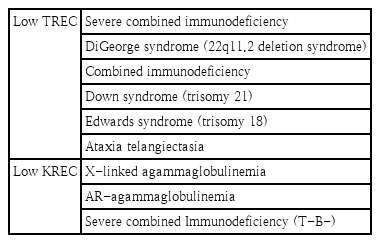
· Early detection of asymptomatic infants with primary immunodeficiencies before the onset of infections enables effective treatment and intervention to prevent serious sequelae.
· T-cell receptor excision circles and kappa-deleting recombination excision circles have recently been used to detect T- or B-cell lymphopenia in neonates.
- Infection
- Babies born to mothers positive for SARS-CoV-2 – Are they in danger?
- Joon Kee Lee
- Clin Exp Pediatr. 2021;64(6):280-281. Published online May 4, 2021
-

Concerns have arisen in the coronavirus disease 2019 (COVID-19) pandemic upon pregnancy and postnatal care starting from reproductive decision-making. To the utmost knowledge, reproductive decisions should not be based primarily on health-related COVID-19 concerns, as the possibility of vertical transmission is negligible and the perinatal outcome is generally not poor compared to pregnancies without COVID-19, as long as infection control measures are well kept.
- Endocrinology
- Pediatricians must consider familial environment when diagnosing and managing childhood obesity
- Young Suk Shim
- Clin Exp Pediatr. 2022;65(1):31-32. Published online April 19, 2021
-
•The prevalence of childhood obesity is increasing worldwide, including in the Republic of Korea, creating a major public healthissue.
•Accumulated evidence indicates a strong relationship between parentalandchildobesity.
•A family-based approach is indicated to prevent and manage childhoodandadultobesity.
- Original Article
- Endocrinology
- Association between polycystic ovary syndrome and risk of attention-deficit/hyperactivity disorder in offspring: a meta-analysis
- Azam Maleki, Saeid Bashirian, Ali Reza Soltanian, Ensiyeh Jenabi, Abdollah Farhadinasab
- Clin Exp Pediatr. 2022;65(2):85-89. Published online April 15, 2021
-
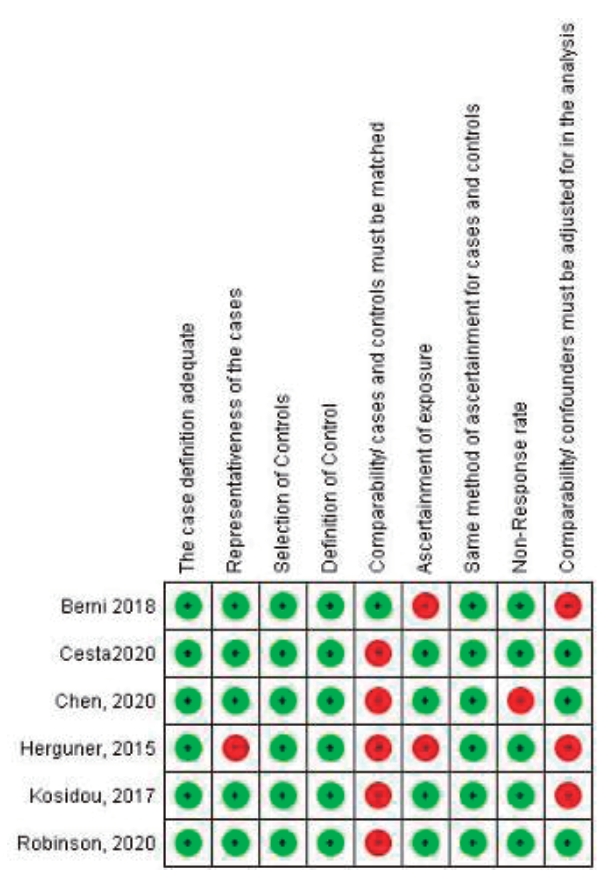
Question: Have polycystic ovary syndrome (PCOS) increased risk of having an offspring with attention-deficit/hyperactivity disorder (ADHD)?
Finding: Six articles (3 cohort and 3 case-control studies; 401,413 total ADHD cases) met the study criteria. Maternal PCOS was associated with an increased risk of ADHD in the offspring based on odds ratio (OR) and relative ratio (RR) (OR, 1.42; 95% confidence interval [CI], 1.27–1.57) and (RR, 1.43; 95% CI, 1.35–1.51), respectively.
Meaning: Our study showed that maternal PCOS is a risk factor for ADHD.
- Review Article
- Infection
- Effects of nasopharyngeal microbiota in respiratory infections and allergies
- Hyun Mi Kang, Jin Han Kang
- Clin Exp Pediatr. 2021;64(11):543-551. Published online April 15, 2021
-

· The nasal microbiota varies with age and is shaped by various factors in healthy individuals.
· The pathological condition of the respiratory tract appears to be associated with reduced nasal microbiota biodiversity, while dysbiosis is involved in the pathophysiology of many respiratory diseases, including otitis, sinusitis, allergic diseases, and lower respiratory infections.
- Original Article
- General Pediatrics
- Efficacy of probiotics for managing infantile colic due to their anti-inflammatory properties: a meta-analysis and systematic review
- Reza Shirazinia, Ali Akbar Golabchifar, Mohammad Reza Fazeli
- Clin Exp Pediatr. 2021;64(12):642-651. Published online April 12, 2021
-
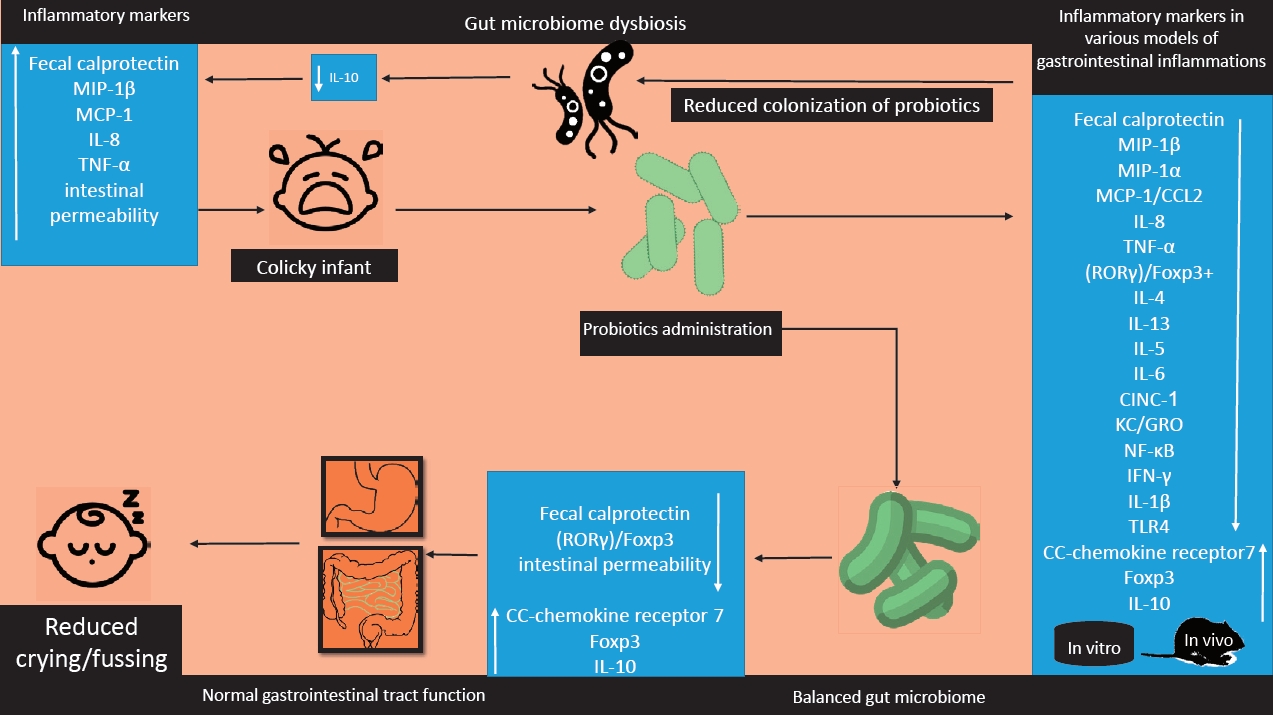
Question: Do probiotics reduce colic symptoms?
Finding: Probiotics reduced colic symptoms in colicky infants probably due to the anti-inflammatory properties.
Meaning: Probiotics may be an effective and less noxious way to manage infantile colic.
- Review Article
- Nephrology (Genitourinary)
- Obesity and chronic kidney disease: prevalence, mechanism, and management
- Hyung Eun Yim, Kee Hwan Yoo
- Clin Exp Pediatr. 2021;64(10):511-518. Published online April 6, 2021
-
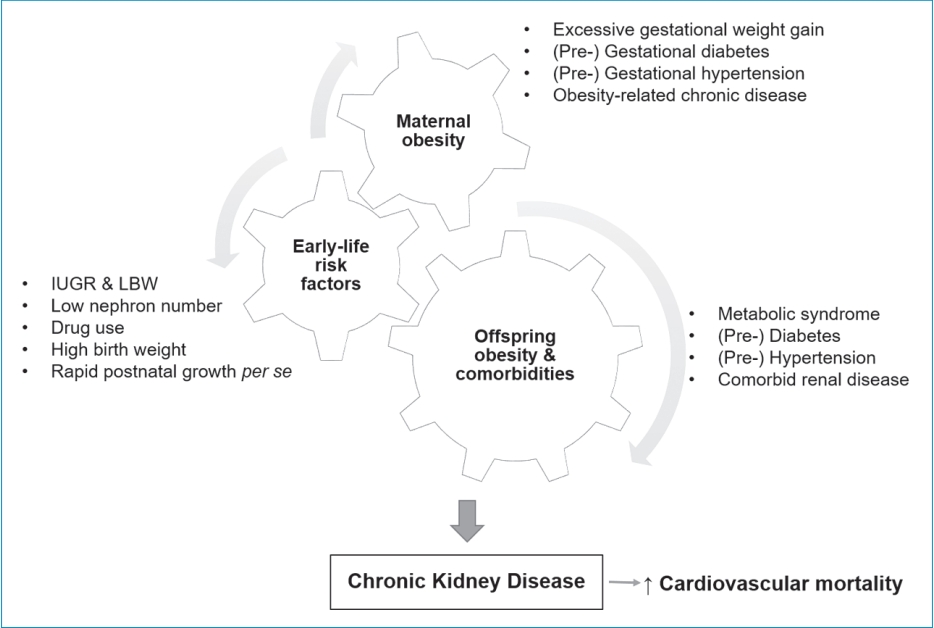
· Obesity is strongly associated with the development and progression of chronic kidney disease.
· Altered renal hemodynamics, metabolic effects, and lipid nephrotoxicity may play a key role in the development of obesity-related kidney disease.
· Children born to obese mothers are at increased risk of developing obesity and chronic kidney disease later in life.
· A multilevel approach is needed to prevent obesity and related chronic diseases.
- Original Article
- General Pediatrics
- Global relationship between parent and child obesity: a systematic review and meta-analysis
- Ju Suk Lee, Mi Hyeon Jin, Hae Jeong Lee
- Clin Exp Pediatr. 2022;65(1):35-46. Published online March 29, 2021
-

Question: Are parent and child obesity correlated worldwide?
Finding: Overweight and obese status of parents and children were significantly associated worldwide. The association between parent and child obesity was stronger in Asia than in Europe and the Middle East, and in high-income than in middle- and low-income countries.
Meaning: Childhood obesity is highly influenced by parental weight status, indicating that parents could play an important role in its prevention.
- Review Article
- Immunology
- Modern diagnostic capabilities of neonatal screening for primary immunodeficiencies in newborns
- Evgenia Olegovna Khalturina, Natalia Dmitrievna Degtyareva, Anastasiia Vasi’evna Bairashevskaia, Alena Valerievna Mulenkova, Anna Vladimirovna Degtyareva
- Clin Exp Pediatr. 2021;64(10):504-510. Published online March 25, 2021
-
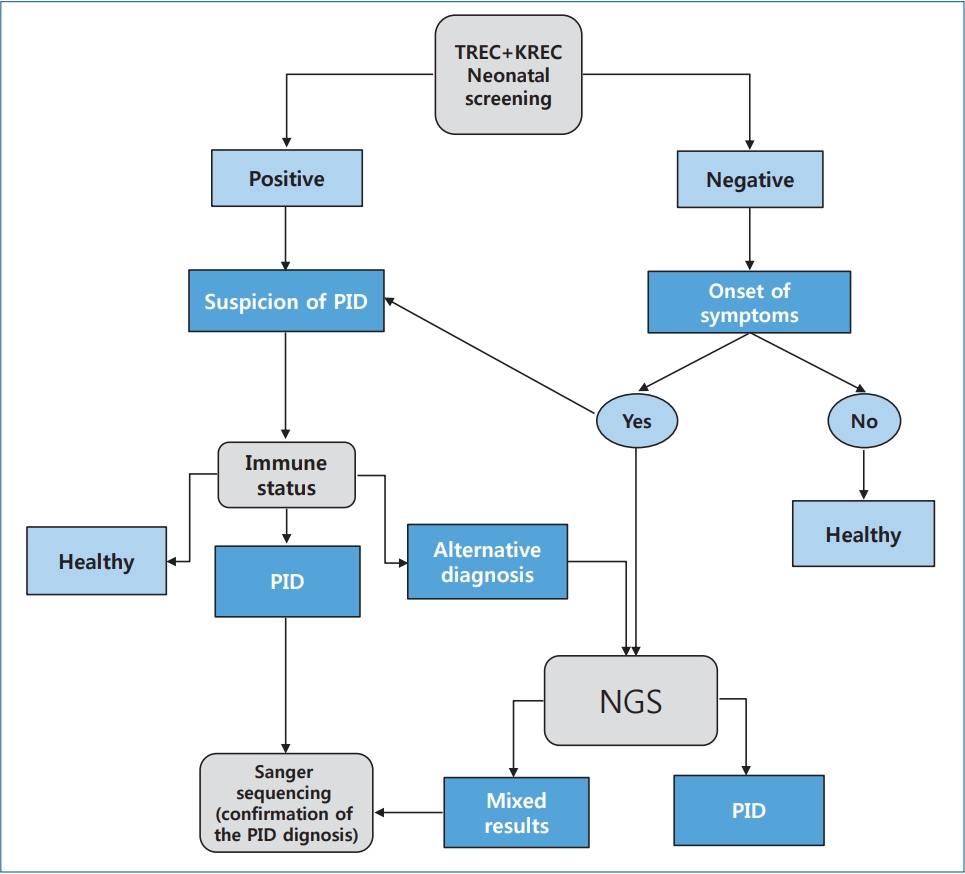
· Neonatal screening for primary immunodeficiency diseases (PIDs) enables early diagnosis and subsequent initiation of therapy.
· Excision of T-cell receptors and kappa-recombination excision circles are cheaper alternative PID screening methods.
· Sanger DNA sequencing remains the reference method for detecting PID; however, next-generation sequencing technology is increasingly used to diagnose it.
· Here we developed a graphical algorithm for diagnosing primary immunodeficiency syndrome based on modern methods of screening for primary immunodeficiencies in newborns.
- Original Article
- Other
- Spatial modeling of mortality from acute lower respiratory infections in children under 5 years of age in 2000–2017: a global study
- Ali Almasi, Sohyla Reshadat, Alireza Zangeneh, Mehdi Khezeli, Raziyeh Teimouri, Samira Rahimi Naderi, Shahram Saeidi
- Clin Exp Pediatr. 2021;64(12):632-641. Published online March 19, 2021
-

Question: We assessed the spatial modeling of mortality from acute lower respiratory infections in children under 5 years old during 2000–2017 using a global data.
Finding: The total number of child deaths during the study period decreased, while the number of hot spots increased among countries.
Meaning: Hot spots were concentrated in Asia in 2000 but shifted toward African countries by 2017. A cold spot formed in Europe over the study period.
- General Pediatrics
- Risk factors for childhood pneumonia: a case-control study in a high prevalence area in Indonesia
- Vivi Ninda Sutriana, Mei Neni Sitaresmi, Abdul Wahab
- Clin Exp Pediatr. 2021;64(11):588-595. Published online March 15, 2021
-

Question: Is the incidence of childhood pneumonia influenced by breastfeeding and basic immunization status?
Finding: Exclusive breastfeeding and complete basic immunization status have an effect in limiting the incidence of childhood pneumonia.
Meaning: While exclusive breastfeeding and complete basic immunization the Expanded Program on Immunization status are important factors for reducing the incidence of childhood pneumonia, indoor air pollution was also a significant risk factor.
-

-
-
8.02023CiteScore94th percentilePowered by
-
Impact Factor3.2
-
- TOPICS
- ARTICLE CATEGORY
- Editorial Office
-
Korean Pediatric Society
#1606 Seocho World Officetel, 19 Seoun-ro, Seocho-ku, Seoul 06732, Korea
Tel: +82-2-3473-7306 Fax: +82-2-3473-7307 E-mail: office@e-cep.org
Clinical and Experimental Pediatrics is an open access journal. All articles are distributed under the terms of the Creative Commons Attribution NonCommercial License (http://creativecommons.org/licenses/by-nc/4.0/)
Copyright © 2025 by Korean Pediatric Society.











